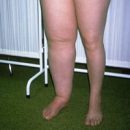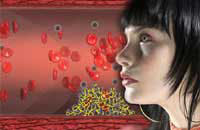Thrombosis of deep veins is a violation of blood under the veins, which arises as a result of the formation of a thrombus in the lumen of the blood vessel. The main symptoms of deep veins thrombosis are swelling in the area of the affected limb, pain painting, skin color changes.
Content
Mechanism for the development of thrombosis
 Most often, thrombophlebitis is formed in pelvis veins, hips, legs, less often in the field of hands, chest or in other areas. According to the arteries, blood enriched with oxygen flows to other organs and tissues. Next, blood, giving oxygen and nutrients, takes the so-called tissues «Slags» And on the veins goes back to the heart. In the lower limbs there are three types of veins. These are superficial, which are under the skin, and deep veins in the thickness of the muscles. These two types of veins are connected to each other perforated veins. They have valves that allow blood flow only in one direction, namely from surface veins to deep. The deep veins of the lower limbs fall into the widest vein of our body - the lower hollow vein, which in turn flows into the right atrium. When thrombosis of the deep veins of the lower extremities in the lumen of the veins, a thrombus is formed, which disrupts blood flow through deep veins to the lower hollow vein.
Most often, thrombophlebitis is formed in pelvis veins, hips, legs, less often in the field of hands, chest or in other areas. According to the arteries, blood enriched with oxygen flows to other organs and tissues. Next, blood, giving oxygen and nutrients, takes the so-called tissues «Slags» And on the veins goes back to the heart. In the lower limbs there are three types of veins. These are superficial, which are under the skin, and deep veins in the thickness of the muscles. These two types of veins are connected to each other perforated veins. They have valves that allow blood flow only in one direction, namely from surface veins to deep. The deep veins of the lower limbs fall into the widest vein of our body - the lower hollow vein, which in turn flows into the right atrium. When thrombosis of the deep veins of the lower extremities in the lumen of the veins, a thrombus is formed, which disrupts blood flow through deep veins to the lower hollow vein.
The mechanism of the occurrence of thrombosis is associated with a violation of the blood coagulation system. When blood becomes more viscous and in the vessel, according to which it flows there with obstacles for normal blood flow, there are prerequisites that promote thrombosis. When a small thrombus is formed on the wall of the vein, it causes inflammation, which leads to the formation of other thrombus.
Blood stagnation in the lower extremities vessels contributes to the development of the deep vein thrombosis of the lower extremities. This state occurs when a person cannot move for a long time. As a result, thrombus are formed.
Causes of deep vein thrombosis
Starting mechanisms leading to the development of thrombophlebitis are considered as follows:
- injury or excessive physical tension
- infection
- Long bedding with surgical, therapeutic or neurological interventions
- postpartum period
- Reception of oral contraceptives (when taking it, blood thickening is noted)
- Oncological diseases (especially lung cancer, stomach and pancreas)
- Blood coagulation disorders
- Long trips (syndrome occurring during long flights on airplanes)
Usually deep vein thrombosis is observed in the field of lower extremities. But recently, thrombosis began to be diagnosed and in the field of hands.
Here are some reasons that contribute to the emergence of deep vein thrombosis in the field of the upper extremities:
- The presence in the vein of the upper limb of the catheter, which causes irritation of the vessel and leads to the formation of a thrombus on its wall
- Availability of an artificial driver of a heart rhythm or an implanted cardiodefactor
- The presence of malignant tumors in the field of veins
- Intensive physical activity on the upper limbs - the trained muscles of the shoulder belt squeeze deep veins and violate the passability in them
The main symptoms of thrombophlebitis
Not always when thrombosis of deep veins of the feet may occur any signs of the disease. Manifestations of symptoms of thrombosis depend on the Localization of the thrombus. About half of the cases of thrombosis of deep veins of the feet passes asymptomatic. This is due to the fact that the broken outflow of blood can be partially recovered through perforant veins on subcutaneous veins.
The main signs of thrombosis of deep veins of the feet are the following signs:
- swelling
- Painting pain, increasing when walking or standing
- Changing the color of the skin, the appearance of a shiny shade
During thrombosis of deep veins in the field of the legs, edema may appear, pain and heat sensation. The development of this disease is dangerous to the emergence of such a state as a pulmonary artery thromboembolism. At the same time, the blood vein torn from the wall of deep veins, rushes with blood flow at the bottom of the hollow vein, falls into the right hearts of the heart, and then from it to the pulmonary artery. There Trombus stuck and breaks blood flow. The manifestations of this state depend on the number of blood clots and the caliber of the clouded pulmonary arteries. Usually it is manifested by a sudden shortness of breath, cutting pain in the chest and hemoplary. In severe cases, this condition may have a fatal outcome.









